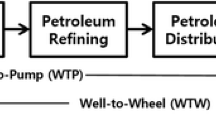Abstract
With LPG automobile deregulation in 2019, the demand for LPG automobiles has increased in Korea; therefore, a comparison of the eco-friendliness of LPG and other petroleum-based vehicles has become necessary. We conducted a well-to-wheels (WTW) analysis of diesel and LPG fuel in Korea. GREET, PRELIM, and GHGenius models were utilized to calculate and appropriately allocate the energy use and greenhouse gas (GHG) emission in the life cycle process of diesel and LPG fuel. In the well-to-tank (WTT) step, the GHG emissions of LPG were lower than that of diesel because of the lower energy consumption of LPG in fuel production. For the WTW comparison, we selected four automobiles currently sold in Korea and a 1,500kg curb weight model. The WTW GHG emissions of the LPG automobiles were lower than those of the diesel SUV and the 1 ton truck. On the other hand, the WTW GHG emissions of diesel automobiles were lower in the sedans and in the 1,500 kg model. Finally, it was verified that LPG automobiles were advantageous in terms of GHG emission in the SUV and one-ton truck, although the GHG emissions of diesel and LPG vehicles can vary depending on the fuel economy of the vehicles.
Similar content being viewed by others
References
Paris Agreement, European Commission. http://ec.europa.eu/clima/policies/international/negotiation s/future/index_en.htm.
U.S. EPA’s Inventory of U.S. Greenhouse Gas Emissions and Sinks: 1990–2017.
IPCC Working Group 3, Climate Change 2014: Mitigation of Climate Change, 5th assessment Report (2014).
The White House Briefing Room, Obama Administration Finalizes Historic 54.5 MPG Fuel Efficiency Standards.
J. Woo, H. Choi and J. Ahn, Transp. Res. D: Transp. Environ., 51, 340 (2017).
Y. Bicer and I. Dincer, Int. J. Hydrogen Energy, 42(6), 3767 (2017).
Korea MOTIE (2019), http://motie.gok/motie/ne/presse/press2/bbs/bbsView.do?bbs_seq_n=161464&bbas_cd_n=81.
S. Unnasch and L. Goyal, Life Cycle Analysis of LPG Transportation Fuels under the Californian LCFS, Life Cycle Associates Report (2017).
F.-S. Boureima, M. Messagie, J. Matheys, V. Wynen, N. Sergeant, J. V. Mierlo, M. D. Vos and B. D. Caevel, World Electr. Veh. J., 3(3), 469 (2009).
ANL (Argonne National Laboratory), GREET 2019 (Greenhouse Gases, Regulated Emissions, and Energy Use in Transportation), 2019.
J. A. Obnamia, G. M. Dias, H. L. Maclean and B. A. Savile, Appl. Energy, 235, 591 (2019).
A. K. Pegallapati and E. D. Frank, Algal Res., 18, 235 (2016).
S. D. Jong, K. Antonissen, R. Hoefnagels, L. Lonza, M. Wang, A. Faaij and M. Junginger, Biotechnol. Biofuels, 10, 64 (2017).
L. G. Pereira, O. Cavalett, A. Bonomi, Y. Zhang, E. Warner and H. L. Chum, Renew. Sustain. Energy Rev., 110, 1 (2019).
(S&T)2 Consultants Inc. GHGenius transportation fuels life cycle assessment model version 5.0. http://www.ghgenius.ca/. (2019).
(S&T)2 Consultants Inc., GHGenius model 4.03, vol. 1: model background and structure, 445 (2013).
(S&T)2 Consultants Inc., GHGenius model 4.03, vol. 2: data and data sources, 57516 (2013).
B. Young, T. Hottle, T. Hawkins, M. Jamieson, G. Cooney, K. Motazedi and J. Bergerson, Environ. Sci. Technol., 53, 2238 (2019).
E. Gencer, S. Torkanmani, I. Miller, T. W. Wu and F. O’Sullivan, Appl. Energy, 277, 115550 (2020).
NETL (National Energy Technology Laboratory), PRELIM (Petroleum Refinery Life Cycle Inventory Model), ver 1.3 (2019).
Petronet (2018) http://petronet.co.kr.
Voyage Calculator (2019). http://sea-distances.org/advanced.
D. Dobrota, B. Lalic and I. Komar, Trans. Marit. Sci., 2, 91 (2013).
A. Elgowainy, J. Han, H. Cai, M. Wang, G. S. Forman and V. B. DiVita, Environ. Sci. Technol., 48, 7612 (2014).
Knoema (2019). http://knoema.com.
J. J. Jang and H. H. Song, Int. J. Life Cycle Assess., 20, 1102 (2015).
Acknowledgement
This work was supported by the National Research Foundation of Korea (NRF) grant funded by the Korea government (MSIP) (NRF-2016R1A5A1009592).
Author information
Authors and Affiliations
Corresponding author
Additional information
Supporting Information
Additional information as noted in the text. This information is available via the Internet at http://www.springer.com/chemistry/journal/11814.
Supporting Information
Rights and permissions
About this article
Cite this article
Kim, M.J., Lee, E.J., Kim, CJ. et al. Life cycle assessment of LPG and diesel vehicles in Korea. Korean J. Chem. Eng. 38, 938–944 (2021). https://doi.org/10.1007/s11814-021-0761-0
Received:
Revised:
Accepted:
Published:
Issue Date:
DOI: https://doi.org/10.1007/s11814-021-0761-0




